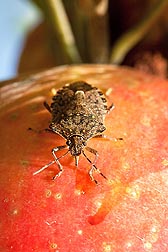Washington, DC, USA
January 7, 2013
 First detected in the United States a decade ago, the brown marmorated stink bug (BMSB) is now in at least 39 states, is wreaking havoc in homes and gardens, and is a major economic threat to orchard fruits, garden vegetables and row crops. It's no wonder the U.S. Department of Agriculture (USDA) ranks this pest as its top "invasive insect of interest."
First detected in the United States a decade ago, the brown marmorated stink bug (BMSB) is now in at least 39 states, is wreaking havoc in homes and gardens, and is a major economic threat to orchard fruits, garden vegetables and row crops. It's no wonder the U.S. Department of Agriculture (USDA) ranks this pest as its top "invasive insect of interest."
But help may be on the way: USDA scientists at the Agricultural Research Service (ARS) Invasive Insect Biocontrol and Behavior Laboratory in Beltsville, Md., are searching for ways to control the stink bug by deciphering its genetic toolkit, studying the pheromones it releases, and evaluating potential attractants for use in commercial traps. ARS is the USDA's principal intramural scientific research agency, and this research supports the USDA priority of promoting international food security.
ARS chemist Ashot Khrimian at the Beltsville lab led a team that identified an "aggregation pheromone" that shows promise as an early-season attractant. The pheromone, released by male stink bugs when they feed, attracts males, females and nymphs (the immature form of the stink bugs) to feeding sites. When mixed with other structurally related chemicals called stereoisomers, the pheromone is relatively simple to synthesize.
Khrimian and Aijun Zhang, an ARS chemist at Beltsville, are completing the identification of exact stereoisomers that the stink bugs are releasing to attract other stink bugs. The mixture and its components also were evaluated by ARS researchers who set up field traps at different sites and with the different candidate formulas, and then counted the numbers of stink bugs they attracted. Data from those field trials, conducted in the summer of 2012, will be added to a previously filed provisional patent application.
Dawn Gundersen-Rindal, the Beltsville lab's research leader, is also looking for genes that might make the stink bug vulnerable to biopesticides or specific treatments that won't harm beneficial insects. In a separate effort, she is working with scientists at Baylor College of Medicine in Houston, Texas, to sequence the stink bug's genome. Sequencing the genome will tell scientists about genes critical to the stink bug's survival and may give them new ways to control the pest.
Read more about this research in the January 2013 issue of Agricultural Research magazine.
Photo by Stephen Ausmus.
Combatiendo el peor insecto plaga invasor en EE.UU.
Detectado por primera vez en EE.UU. hace una década, el chinche apestoso marrón marmolado (Halyomorpha halys, o BMSB por sus siglas en inglés) ahora infesta por lo menos 39 estados en EE.UU., causa muchos daños en hogares y jardines, y es una mayor amenaza económica a las frutas del huerto, las verduras del jardín, y los cultivos de campo. No es sorprendente que el Departamento de Agricultura de EE.UU. (USDA por sus siglas en inglés) considere este insecto como su principal "insecto invasor de interés".
Pero la ayuda está en camino: Científicos del Servicio de Investigación Agrícola (ARS) en el Laboratorio del Biocontrol y Comportamiento de Insectos Invasores mantenido por el ARS en Beltsville, Maryland, están buscando maneras de controlar el chinche apestoso por medio de descifrar su genética, estudiar sus feromonas, y evaluar posibles cebos para utilización en trampas comerciales. ARS es la agencia principal de investigaciones científicas del USDA, y esta investigación apoya la prioridad del USDA de promover la seguridad alimentaria internacional.
Químico Ashot Khrimian en el laboratorio en Beltsville dirigió un grupo que identificó una "feromona de agregación" que podría servir como un cebo para atraer los chinches. Esta feromona, la cual es emitida por el macho del insecto cuando ellos se alimentan, atrae los machos, las hembras y las ninfas (la forma inmadura del chinche) a los sitios de alimentación. Cuando mezclada con otros compuestos químicos similares llamados estereoisómeros, la feromona es relativamente fácil de sintetizar.
Khrimian y Aijun Zhang, quien también es químico en Beltsville, están terminando la identificación de los estereoisómeros precisos emitidos por los chinches apestosos para atraer otros chinches. La mezcla y sus componentes también fueron evaluados por investigadores del ARS que pusieron trampas en diferentes sitios y con diferentes formulaciones, y luego contaron el número de chinches atraídos. Los datos que resultaron de estas pruebas de campo realizadas en el verano del 2012 se agregarán a una solicitud de patente sobre los atrayentes.
Dawn Gunderson-Rindal, quien es líder del laboratorio en Beltsville, también está buscando los genes que podrían aumentar la vulnerabilidad del chinche a los biopesticidas o tratamientos específicos que no dañan a los insectos beneficiosos. En otro estudio, ella está colaborando con científicos del Colegio Baylor de Medicina en Houston, Texas, para secuenciar el genoma del chinche apestoso. Esta secuenciación podría proveerles a los científicos información sobre los genes que tienen un papel imprescindible en la supervivencia del chinche y también podrían sugerir nuevos métodos de controlar el insecto plaga.
Lea más sobre esta investigación en la revista 'Agricultural Research' de enero del 2013.